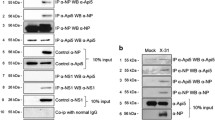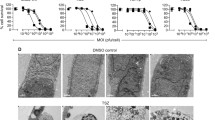Abstract
Most serotypes of human adenoviruses, except subgroup C viruses such as serotype 2 (Ad2) and Ad5, can grow only to low titers in vitro in human cell lines. To analyze the properties of the replicative cycles of poorly growing Ad serotypes, we compared Ad37 and Ad5 in human A549 cells. In comparison with Ad5, Ad37 showed a slower development of viral-induced cytopathic effects and prolonged cell viability. Furthermore, the maximum yields of progeny viruses were reduced by almost 100-fold. Although the amount of viral DNA and E1A mRNA in infected cells reached comparable levels between these two serotypes, the accumulation of viral late mRNAs and structural proteins in Ad37-infected cells was severely reduced. Overall, our study explains critical steps in the replicative cycle of Ad, which cause serotype-specific restrictions in permissive human cell lines.




Similar content being viewed by others
References
Arnberg N, Mei Y, Wadell G (1997) Fiber genes of adenoviruses with tropism for the eye and the genital tract. Virology 227:239–244
Arnberg N, Edlund K, Kidd AH, Wadell G (2000) Adenovirus type 37 uses sialic acid as a cellular receptor. J Virol 74:42–48
Arnberg N, Kidd AH, Edlund K, Olfat F, Wadell G (2000) Initial interactions of subgenus D adenoviruses with A549 cellular receptors: sialic acid versus alpha(v) integrins. J Virol 74:7691–7693
Arnberg N, Pring-Akerblom P, Wadell G (2002) Adenovirus type 37 uses sialic acid as a cellular receptor on Chang C cells. J Virol 76:8834–8841
Berk JA (2007) Adenoviridae: the viruses and their replication. In: Knipe DM, Howley PM (eds) Fields virology, 5th edn. Lippincott, Philadelphia, pp 2355–2394
Cashman SM, Morris DJ, Kumar-Singh R (2004) Adenovirus type 5 pseudotyped with adenovirus type 37 fiber uses sialic acid as a cellular receptor. Virology 324:129–139
Dobner T, Kzhyshkowska J (2001) Nuclear export of adenovirus RNA. Curr Top Microbiol Immunol 259:25–54
Eggerding FA, Pierce WC (1986) Molecular biology of adenovirus type 2 semipermissive infections. I. Viral growth and expression of viral replicative functions during restricted adenovirus infection. Virology 148:97–113
Flint SJ, Gonzalez RA (2003) Regulation of mRNA production by the adenoviral E1B 55-kDa and E4 Orf6 proteins. Curr Top Microbiol Immunol 272:287–330
Ford E, Nelson KE, Warren D (1987) Epidemiology of epidemic keratoconjunctivitis. Epidemiol Rev 9:244–261
Goodrum FD, Ornelles DA (1998) p53 status does not determine outcome of E1B 55-kilodalton mutant adenovirus lytic infection. J Virol 72:9479–9490
Hochstein N, Webb D, Hosel M, Seidel W, Auerochs S, Doerfler W (2008) Human CAR gene expression in nonpermissive hamster cells boosts entry of type 12 adenovirions and nuclear import of viral DNA. J Virol 82:4159–4163
Hosel M, Webb D, Schroer J, Doerfler W (2003) The abortive infection of Syrian hamster cells with human adenovirus type 12. Curr Top Microbiol Immunol 272:415–440
Jones N, Shenk T (1979) Isolation of adenovirus type 5 host range deletion mutants defective for transformation of rat embryo cells. Cell 17:683–689
Kafatos FC, Jones CW, Efstratiadis A (1979) Determination of nucleic acid sequence homologies and relative concentrations by a dot hybridization procedure. Nucleic Acids Res 7:1541–1552
Kemp MC, Hierholzer JC, Cabradilla CP, Obijeski JF (1983) The changing etiology of epidemic keratoconjunctivitis: antigenic and restriction enzyme analyses of adenovirus types 19 and 37 isolated over a 10-year period. J Infect Dis 148:24–33
Klimkait T, Doerfler W (1985) Adenovirus types 2 and 5 functions elicit replication and late expression of adenovirus type 12 DNA in hamster cells. J Virol 55:466–474
Klimkait T, Doerfler W (1987) E1B functions of type C adenoviruses play a role in the complementation of blocked adenovirus type 12 DNA replication and late gene transcription in hamster cells. Virology 161:109–120
Lucher LA (1995) Abortive adenovirus infection and host range determinants. Curr Top Microbiol Immunol 199:119–152
Reed LJ, Muench H (1938) A simple method of estimating fifty percent endpoints. Am J Hyg 27:493–497
Robinson CM, Shariati F, Gillaspy AF, Dyer DW, Chodosh J (2008) Genomic and bioinformatics analysis of human adenovirus type 37: new insights into corneal tropism. BMC Genomics 9:213
Roelvink PW, Lizonova A, Lee JG, Li Y, Bergelson JM, Finberg RW, Brough DE, Kovesdi I, Wickham TJ (1998) The coxsackievirus–adenovirus receptor protein can function as a cellular attachment protein for adenovirus serotypes from subgroups A, C, D, E, and F. J Virol 72:7909–7915
Sawada Y, Raska K Jr, Shenk T (1988) Adenovirus type 5 and adenovirus type 12 recombinant viruses containing heterologous E1 genes are viable, transform rat cells, but are not tumorigenic in rats. Virology 166:281–284
Schiedner G, Schmitz B, Doerfler W (1994) Late transcripts of adenovirus type 12 DNA are not translated in hamster cells expressing the E1 region of adenovirus type 5. J Virol 68:5476–5482
Turnell AS, Grand RJ, Gallimore PH (1999) The replicative capacities of large E1B-null group A and group C adenoviruses are independent of host cell p53 status. J Virol 73:2074–2083
Woo JL, Berk AJ (2007) Adenovirus ubiquitin-protein ligase stimulates viral late mRNA nuclear export. J Virol 81:575–587
Wu E, Trauger SA, Pache L, Mullen TM, von Seggern DJ, Siuzdak G, Nemerow GR (2004) Membrane cofactor protein is a receptor for adenoviruses associated with epidemic keratoconjunctivitis. J Virol 78:3897–3905
Yu L, Hamada K, Namba M, Kadomatsu K, Muramatsu T, Matsubara S, Tagawa M (2004) Insertion of an exogenous promoter in the E1A regulatory region of adenovirus does not disturb viral replication despite reduced E1A transcription. Cancer Lett 203:51–57
Zhang Y, Bergelson JM (2005) Adenovirus receptors. J Virol 79:12125–12131
Zock C, Doerfler W (1990) A mitigator sequence in the downstream region of the major late promoter of adenovirus type 12 DNA. EMBO J 9:1615–1623
Zock C, Iselt A, Doerfler W (1993) A unique mitigator sequence determines the species specificity of the major late promoter in adenovirus type 12 DNA. J Virol 67:682–693
Acknowledgments
We thank Ms. H. Shiiba for technical assistance in the propagation and purification of Ad5 and Ad37 viruses, and Dr. M. Noda (Hiroshima City Institute of Public Health) for providing us with Ad37. This research was supported by a Grant to “Academic Frontier” Project of the Saitama Medical University Research Center for Genomic Medicine.
Author information
Authors and Affiliations
Corresponding author
Rights and permissions
About this article
Cite this article
Adachi, K., Mitani, K. Insufficient accumulation of viral late mRNAs restricts the replicative cycle of human adenovirus type 37 in A549 cells. Arch Virol 154, 1401–1407 (2009). https://doi.org/10.1007/s00705-009-0451-4
Received:
Accepted:
Published:
Issue Date:
DOI: https://doi.org/10.1007/s00705-009-0451-4




